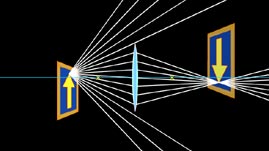When light travels across the boundary between two transparent materials, it is refracted—in other words, it bends. A lens, a transparent object that is shaped to refract light in specific ways, causes light rays to either converge or diverge after passing through it. In general, a converging lens is made with convex (outward-curving) surfaces, while a diverging lens is made with concave (inward-curving) surfaces.
With a converging lens, rays of light entering the lens parallel to the principal axis (the line that passes through the center of the lens) are refracted towards the axis and converge at a common point on the axis known as the focal point. The radius of curvature of the lens and the refractive index of the lens material determine the focal length (the distance from the lens to the focal point). There are two focal points, one located on each side of the lens.
The behavior of light passing through a converging lens follows certain rules. For example, if the incident (incoming) ray travels through the center of the lens, the ray does not undergo refraction and continues in the same direction. If the incident ray enters the lens parallel to the principal axis, the refracted ray passes through the focal point on the opposite side. If the incident ray passes through the focal point before entering the lens, the refracted ray travels parallel to the axis.
At the point where the refracted rays intersect, an image is formed. Converging lenses produce both real and virtual images. A real image forms when the refracted rays intersect after passing through the lens; a screen placed at the plane of convergence will show an inverted image. The closer the object is to the lens (but still farther away than the focal point), the larger the image is and the farther it is from the lens.
A virtual image is formed if the object is located at a distance less than one focal length from the front of the lens. When this is the case, the light diverges after refraction. The virtual image appears upright, in front of the lens, and at the location where the refracted rays would meet if they were traced backwards. To an observer, light appears to come from the location of the virtual image, but it is not real; a screen placed at the plane of apparent convergence would not show an image. The more distant the object is from the lens (but closer than the focal point), the larger the virtual image is and the farther it is from the lens.
Another variable that affects how much light is captured and refracted when an image is formed is diameter—the larger the diameter of the lens, the more light passes through it and the brighter the image.

 Teachers' Domain is proud to be a Pathways portal to the National Science Digital Library.
Teachers' Domain is proud to be a Pathways portal to the National Science Digital Library.